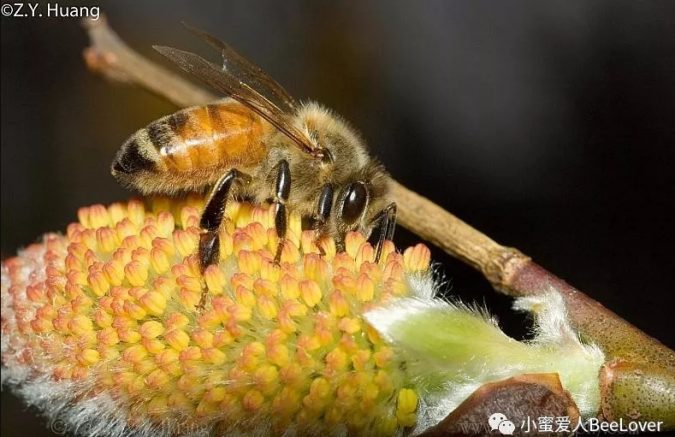| Family | Salicaceae |
| Genus | Salix |
| Species | S. discolor |
| Common names | pussy willow |
| ZBAS | 10 |
Willow is dioecious, meaning the two sexes have difference “houses” (i.e. different plants). The two genders are different in color, the male flower is fluffy, yellow to off-white, and the female flower is green (I haven’t seen it before!). The Chinese common name “willow of faded color” is actually because of the Latin name: discolor (two colors) became confused with discolored.
The common name in English is pussy willow. It is said that in winter the male tree will have beautiful inflorescence (catkins) shaped like cat’s paw, hence the name. Again I have not seen them.
But what I did see, were many male flowers during bloom. because there are many bees (you can hear the buzz far away)! The male flowers have lots of pollen and nectar. This flower is an native plant in the US. It is usually a bush, but it can grow to 3-4 people tall, but the branches are still very thin.
1. The first batch of photos were taken on April 31, 2006, D70 (6 megapixels). This is before flowers are blooming. 
2. These photos all used flash to darken the background.
3. The bees are clearly collecting honey.
4. Younger flowers are yellowish red. 
5. The second batch of photos were taken on March 26, 2014. Now the flowers are in full bloom.
6. The flower then turns yellow, and finally turns white. This is not a honey bee, but a solitary bee.
7. These flowers are more whitish (near the end of bloom) — so perhaps faded color is also ok :)
8. This year, it bloomed on April 21, 2019. I took a visitor to study the flowers. The black spots on the blue sky background were all bees, most of them were solitary bees. There were also many honey bees.


Hi,
Have you see a female pussy willow tree/shrub that looks like a fuzzy caterpillars? Or does the male pussywillow when pollinated break open to reveal the fertilized female catkin? I know they’re not wind pollinated. Even an old farmer friend didn’t know about a female pussywillow. So I am asking you. Sincerely, Susan Rice
The fuzzy ones are males like in my photo. The females should be shaped differently.